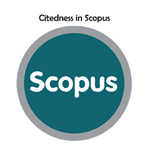Perbandingan Kadar Kafein pada Jenis Kopi Hasil Perkebunan Bengkulu dengan Metode Spektrofotometri Ultraviolet
Abstract
Keywords
Full Text:
PDFReferences
A. Rohman, Analisis Obat. UGM PRESS, 2018.
A. Ayelign and K. Sabally, "Determination of chlorogenic acids (CGA) in coffee beans using HPLC" American Journal of Research Communication, vol. 1, no. 2, pp. 78-91, 2013.
S. J. Suhasini and G. Sethu, "Intake of caffeine" Journal of Pharmaceutical Sciences and Research, vol. 7, no. 6, p. 355, 2015.
R. K. Maramis, "Analisis kafein dalam kopi bubuk di Kota Manado menggunakan spektrofotometri UV-VIS" Pharmacon, vol. 2, no. 4, 2013. https://doi.org/10.35799/pha.2.2013.3100.
D. Perkebunan, "Statistik Perkebunan Indonesia 2014-2016, Kopi" Direktorat Jenderal Perkebunan, Jakarta, 2015.
E. Mulyani, "ANALISIS KADAR KAFEIN PADA KOPI BUBUK DI KOTA BENGKULU MENGGUNAKAN SPEKTROFOTOMETRI ULTRAVIOLET" Jurnal Penelitian dan Kajian Ilmiah Kesehatan Politeknik Medica Farma Husada Mataram, vol. 5, no. 1, pp. 59-64, 2019.
I. Sudarmanto, "Profil Klt Beberapa Jenis Kopi di Sumatera dan Potensi Antioksidannya" JFL: Jurnal Farmasi Lampung, vol. 8, no. 1, pp. 15-20, 2019. https://doi.org/10.37090/jfl.v8i1.82.
M. A. Mustapa, M. Taupik, and M. H. Effendi, "Identification new derivative clorogenic acid from coffee pinogu gorontalo with LCMS method" RESEARCH JOURNAL OF PHARMACEUTICAL BIOLOGICAL AND CHEMICAL SCIENCES, vol. 10, no. 1, pp. 341-347, 2019.
N. P. Tjahjani, A. Chairunnisa, and H. Handayani, "ANALISIS PERBEDAAN KADAR KAFEIN PADA KOPI BUBUK HITAM DAN KOPI BUBUK PUTIH INSTAN SECARA SPEKTROFOTOMETRI UV-Vis." Cendekia Journal of Pharmacy, vol. 5, no. 1, pp. 52-62, 2021. https://doi.org/10.31596/cjp.v5i1.90.
N. H. Fajriana and I. Fajriati, "Analisis Kadar Kafein Kopi Arabika (Coffea arabica L.) pada Variasi Temperatur Sangrai secara Spektrofotometri Ultra Violet" Analit: Analytical and Environmental Chemistry, vol. 3, no. 2, 2018. http://dx.doi.org/10.23960%2Faec.v3i2.2018.p.
S. Srikandi, A. W. Kristanti, and R. T. M. Sutamihardja, "Tingkat Kematangan Biji Kopi Arabica (Coffea Arabica l.) dalam Menghasilkan Kadar Kafein" JURNAL SAINS NATURAL, vol. 9, no. 1, pp. 22-28, 2019. https://doi.org/10.31938/jsn.v9i1.189.
G. ALPDOÄžAN, K. Karabina, and S. Sungur, "Derivative spectrophotometric determination of caffeine in some beverages" Turkish Journal of Chemistry, vol. 26, no. 2, pp. 295-302, 2002.
K. Indonesia, "Farmakope Indonesia (Edisi V)" Jakarta: Direktorat Jenderal Bina Kefarmasian dan Alat Kesehatan, 2014.
D. Nafisah and T. D. Widyaningsih, "Kajian metode pengeringan dan rasio penyeduhan pada proses pembuatan teh cascara kopi arabika (Coffea arabika L.)" Jurnal Pangan dan Agroindustri, vol. 6, no. 3, 2018.
G. W. David, "Pharmaceutical Analysis A textbook for pharmaceutical students and pharmaceutical chemists." Elsevier Sciences Ltd, 2ndedn.
AGUSTINA, Raida, et al. Pengaruh suhu dan lama penyangraian terhadap sifat fisik-kimia kopi arabika dan kopi robusta. In: Prosiding Seminar Nasional Inovasi Teknologi Untuk Masyarakat. 2019. p. 285-299. https://doi.org/10.22373/amina.v2i2.700.
DOI: https://doi.org/10.37311/ijpe.v2i3.15492
Refbacks
- There are currently no refbacks.
Copyright (c) 2022 elly mulyani, Herlina Herlina, Dewi Winni Fauziah, Aina Fatkhil Haque

Indonesian Journal of Pharmaceutical Education is licensed under a Creative Commons Attribution-NonCommercial-ShareAlike 4.0 International License.



